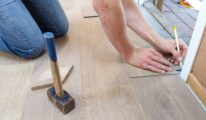Getting around your home should be a breeze. That’s especially true for those in a wheelchair. The type of flooring you have has a direct impact on wheelchair maneuverability. One should also consider the durability, ease of care, and aesthetics when choosing your flooring.
Magee Rehabilitation, a rehabilitation hospital (part of Jefferson Health) located in Philadelphia, talked to their Peer Mentor Group to get advice on the best types of flooring for wheelchair users. It was unanimous that carpet was the most difficult to get around on and maintain, and hardwood was the most recommended.
Here is some of the peer alumni’s advice:
- “Tile, linoleum, laminate, and hardwood are all good for wheelchair maneuverability. When it comes to laminate and linoleum, long-term durability is a concern with laminate and linoleum. If you do choose one of those types of flooring, get a high grade.”
- “If you go with laminate, make sure it’s industrial. I’ve had the wear of the tires cause it to pull up at the seams. Also, the laminate faded in heavy traffic areas. I now have hardwood throughout and love it. The only concern is finding area rugs that are very low profile. The non-skid carpet lining for under area rugs works well.”
- “Tight grooved wood is great. Laminated floors are less expensive, but you need a good grade. With tile, the grout can get dirty.”
- “I recommend an engineered hardwood because it is smooth, attractive, and durable. I wish I would have done the engineered over the solid.”
- “The transition of flooring from one room to another is of utmost importance. We ended up with a quarter to a half inch difference in the floor height between the dining room and kitchen and between the living room and the entryway. Now, I must pop over the threshold which isn’t a huge problem, but it could cause a drink on my lap to spill if I’m not very careful.”
- “Look for wood that is “tongue and groove” pre-cut. That means every board will lock into each other when you lay them down, keeping them snug and preventing them from buckling for your wheelchair when turning. It can also handle the weight of any power chair.”
- “We decided on porcelain tile for its resistance to weight and wear-and-tear. Our house originally had wood and the parts where we kept it have suffered. Another alternative is a tile that looks like wood. It’s visually appealing and everyone thinks its bamboo.”
May is National Home Improvement month. If renovating your floors is on your to-do list, consider an option that is wheelchair friendly. For more tips on how to make your home compatible for wheelchairs, check out Magee’s full wheelchair usage guide.





